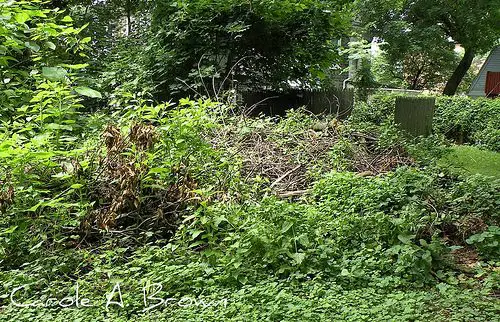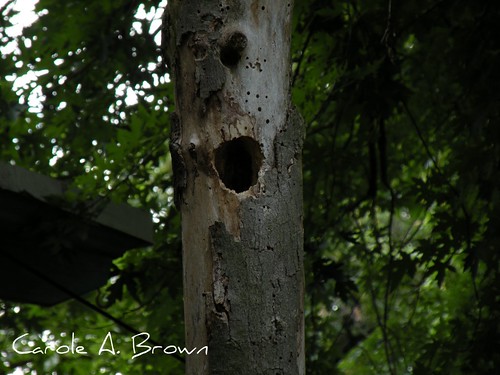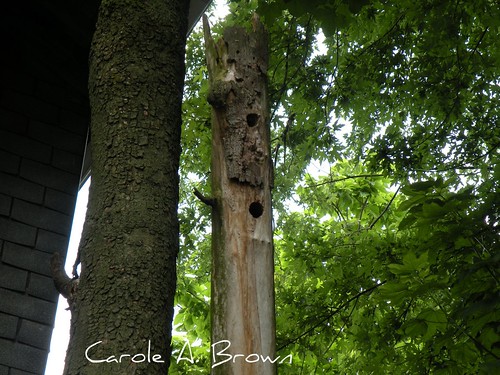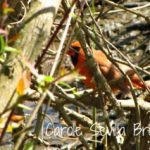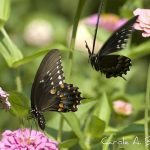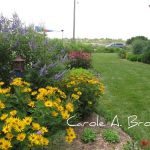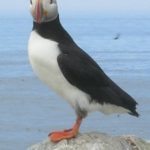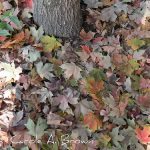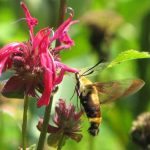I had a bit of a rant about my neighbor’s invasive Norway Maple trees, but at least there has been two benefits of having these trees so near to my house.
Benefits? Am I kidding? Yes, these are truly nasty trees in their impact on native ecosystems, but let’s make a little lemonade, shall we?
The first benefit comes from the brush pile that’s made from all the branches that drop from the trees every time the wind blows. Our neighbor’s handyman started this pile so he could mow the lawn. Before he could even begin mowing, he’d walk around and drag all of the fallen branches to a spot visible from my deck.
Over time, we have added to this pile, dragging the large branches that fell into the yard, landed on my roof, or crashed onto the deck through the fence and throwing them onto this pile.
Even though I really hate these trees, I’ve discovered that this brush pile is a bonanza to all kinds of wildlife, including Cardinals, wrens, thrushes, warblers, sparrows, as well as toads, snakes, squirrels, and overwintering butterflies.
I’ve spent hours perched on my deck, binoculars in hand, watching a seemingly endless parade of birds and other wildlife as they used this pile for cover and picking among the twigs for bugs and other tasty snacks.
Brush piles are a very important habitat element for many different kinds of wildlife. They provide cover from predators and places for nests, escape routes, and dens. Many insects are attracted to this pile of decomposing wood, which provides a bounty of food for birds, amphibians, reptiles, and mammals.
And the best part is, brush piles are very easy to build, and they keep a lot of yard waste out of landfills:
- Start with the largest branches and logs and loosely stack them log cabin style.
- Do not use pressure treated lumber, creosoted railroad ties, tires, or lead-painted lumber as these materials contain toxic chemicals which leech into the soil and pollute our waterways.
- Rocks and stones can also be used in this base section to provide additional hiding spaces for wildlife.
- Cover the top of this base with smaller branches until you have a tall pile that resembles an igloo.
- The pile will shrink every year as the wood decomposes and you can just keep adding new materials to the top.
- Plant native vines such as Virginia Creeper (Parthenocissus quinquefolia), Trumpet Honeysuckle (Lonicera sempervirens), or American Bittersweet (Celastrus scandens) around the base to provide more shelter and to hide the pile. Do NOT plant Oriental Bittersweet (Celastrus orbiculatus) because it is extremely invasive and difficult to eradicate.
- Border the pile with locally native wildflowers, which provide nectar for native pollinators.
- Or screen the pile with fruiting native shrubs which provide much needed food for wildlife, especially migrating birds.
That’s it. You’ve now added a very important habitat element for wildlife in your garden. You can now sit back and watch the birds and other wildlife make use of your gift to them. Grab a cup of coffee, pull up a chair, and enjoy the show.
What’s the second benefit provided by these noxious trees? Woodpeckers!
We have watched Downy Woodpeckers, Hairy Woodpeckers, Northern Flickers, Red-bellied Woodpeckers, and Yellow-bellied Sapsuckers successfully build their nests and raise their young in the trunks of these trees, especially the trunks where the tops have snapped off.
Every spring the air is filled with the wonderful tap-tap-tapping sound of all the woodpeckers who are drilling out a new nest hole. The nest building is amazing to watch as each member of the pair takes turn drilling away and tossing the chips out of the hole.
But nothing is as exciting as the day the young fledglings emerge from the hole for their first flight!
I am so happy that we have gotten a double dose of “lemonade” in the form of necessary habitat elements for the wildlife around me from these trees that should never be planted in any landscape.
What wildlife comes to your brush pile? What other habitat elements do you have in your garden? Share your sightings in the comments below.
Here’s some other habitat element to add to your Ecosystem Garden:
How to Install a Dragonfly Pond
More From Ecosystem Gardening:
Submit your review | |
Great article dead wood has as much life to it as living trees and should be valued as such. Brush not only makes good piles it makes great mulch/fertilizer for shrubs and brambles. You can have much of the benefits of the pile, Dr. Tallamy's caterpillars are fond of rubus leaves and I am fond of raspberries and blackberries.
Just another idea of what to do with brush.

